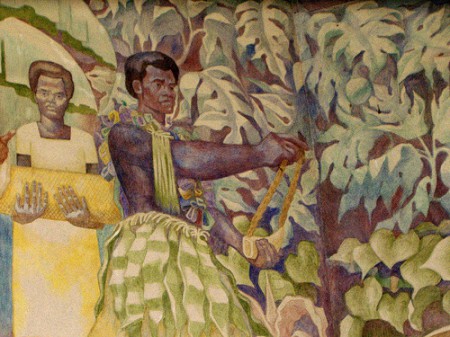 If you consider genebanks as sources primarily of information — the genetic information contained in samples — then racks of sealed foil pouches and guarantees that 99% of the genetic diversity has been captured are probably deeply reassuring. There’s another side to storing biodiversity, though. Seedbanks (though often used interchangeably with “genebanks”) store a greater bulk of seeds often with the specific purpose not of making their genetic information available, but with the idea of using the seeds to restore the plant diversity of some damaged or degraded ecosystem.
If you consider genebanks as sources primarily of information — the genetic information contained in samples — then racks of sealed foil pouches and guarantees that 99% of the genetic diversity has been captured are probably deeply reassuring. There’s another side to storing biodiversity, though. Seedbanks (though often used interchangeably with “genebanks”) store a greater bulk of seeds often with the specific purpose not of making their genetic information available, but with the idea of using the seeds to restore the plant diversity of some damaged or degraded ecosystem.
The Millennium Seed Bank at Kew, for example, is explicit about this goal:
Restoring damaged habitats around the world is becoming an increasingly important aspect of our work.
The loss of ecosystem services from degraded habitats is a significant barrier to achieving international goals to reduce poverty, hunger and disease. Kew’s Breathing Planet programme aims to establish a global network of scientists and practitioners to use seed banks for the urgent repair and re-establishment of damaged native vegetation.
How realistic is this? An article in the latest Science says that the qualities stored in most seedbanks (and Kew is probably better than most) is “well short of the amount required to restore at the landscape-scale”. ((David J. Merritt, & Kinsley W Dixon (2011). Restoration Seed Banks—A Matter of Scale Science. Proper reference to come as soon as it is available.)) It isn’t just the amount of seed either:
[M]ost seed banks are missing the technological resources and capacity to deliver landscape-scale restoration.
I had no idea that using seeds to restore ecosystems in this way was so huge. Merritt and Kingsley work in Western Australia, where the Gondwana Link Project “aims to repatriate with local indigenous species many thousands of hectares of former farmland to create a biological corridor spanning 1000 km” and where “land areas disturbed by mining in the biodiverse semiarid region of the Pilbara … exceed 20,000 ha”. Overall, they say that “restoration is now a global business worth at least $1.6 trillion annually and likely to grow substantially”.
Against that background a little successful research, for example to improve survival in storage or germination rates and establishment, could have a huge impact. Take the example of that Pilbara region.
Current seeding rates for restoration in this region are 5 to 7kg/ha, and an average seed price is $749 ± 65 per kg, based on the available seed prices from commercial suppliers for 88 dominant Pilbara plant species. If restoration research reduced the number of seeds required to achieve plant establishment targets by 30%, this research effort would represent a reduction in seed use of ~30 to 42 tons and a saving of $20 to $34 million in seed purchase costs. (References removed.)
What has any of this to do with agricultural biodiversity? Not a lot, at first sight. Merritt and Dixon do point to the possibility of connecting these vast restoration efforts to local communities by integrating opportunities to develop traditional foods and medicines. But do the people who are now storing and then sowing tonnes of wild seeds even consider the need also to store useful species and the traditional knowledge to make use of them? The authors also appeal to “a village cattleman from Sudan” who pleaded with delegates at COP10 in Nagoya, Japan, last year “for answers, technical guidance and support that he could take back to his community so he and his family could cope with the impending changes to his livelihood”. Merritt and Dixon offer “effective and timely restoration”.
I’d like respectfully to suggest that perhaps a little support for genebanks from the trillion-dollar business of ecological restoration from seedbanks might do some good too.
